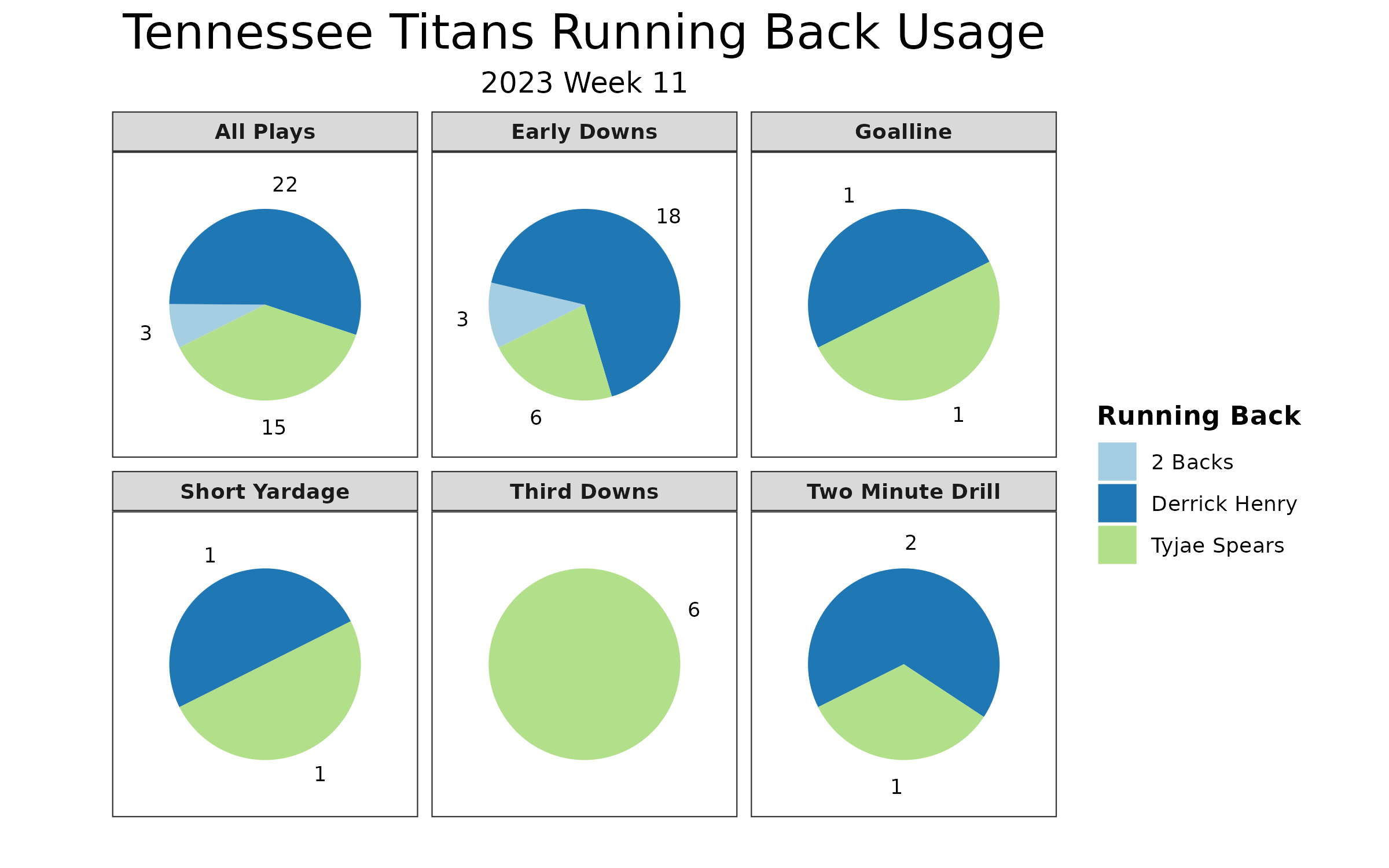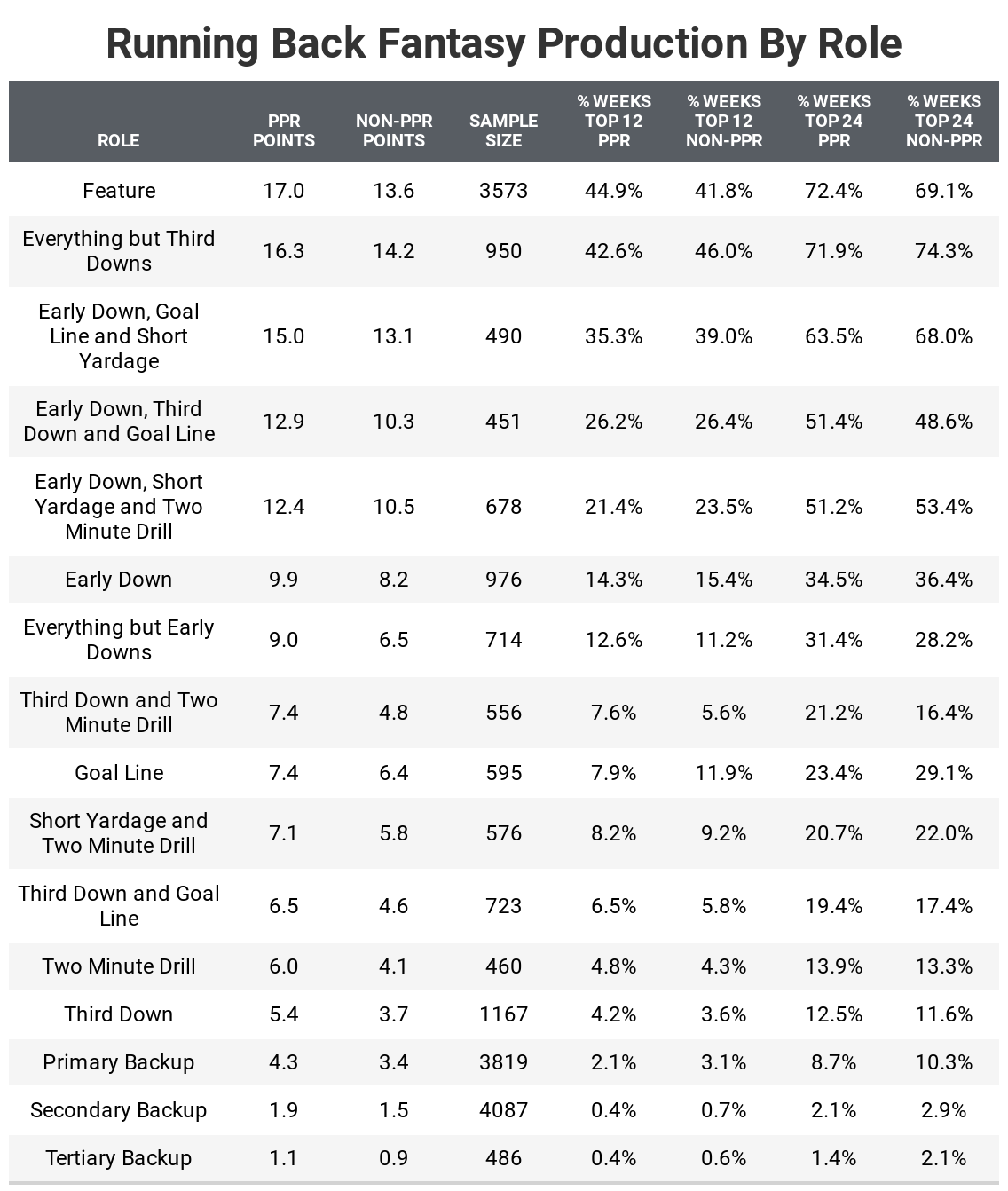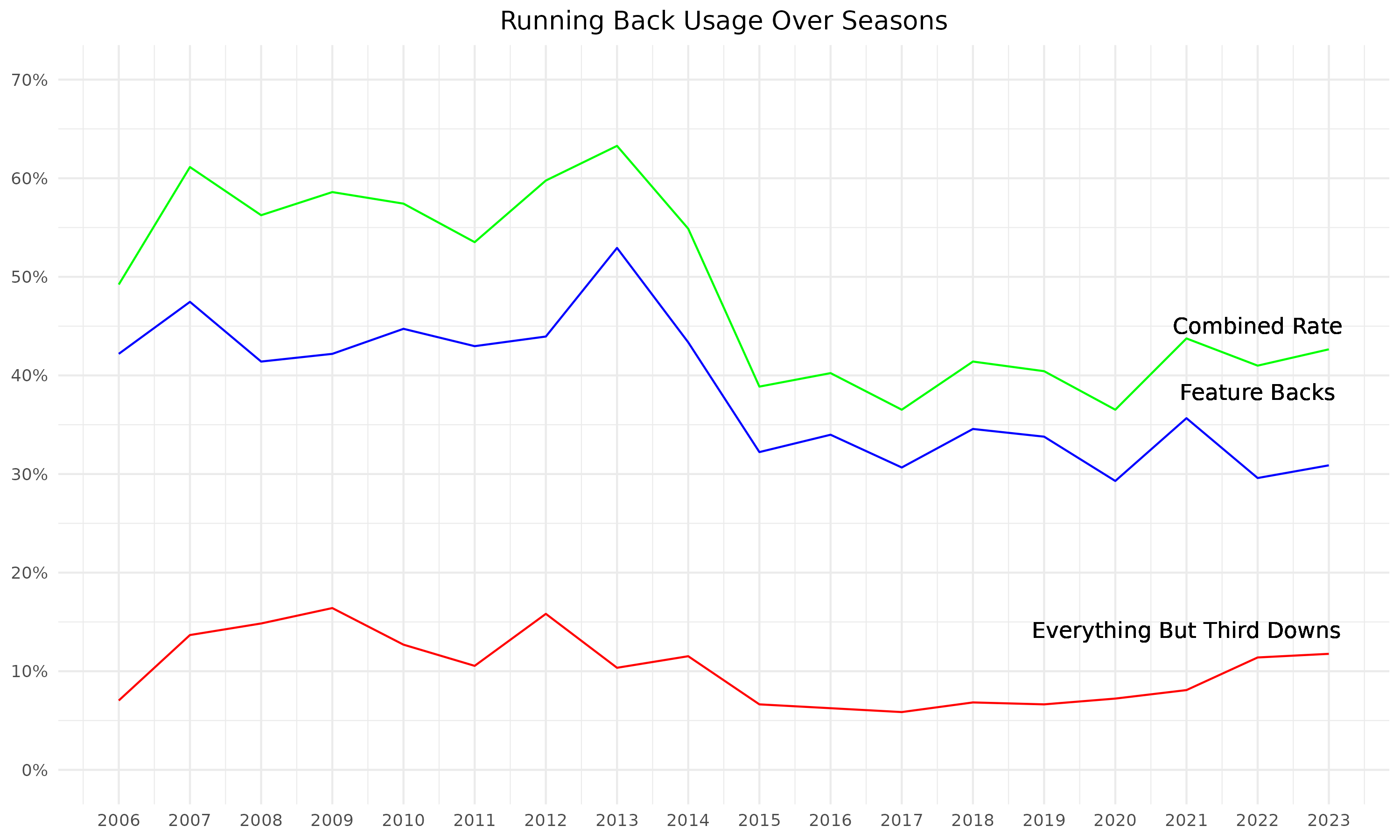• Running backs don’t always need third downs: Running backs who have the early down role as well as short yardage, goal line and two-minute drill roles are still consistent fantasy starters.
• The decline of the feature running back: Nine years ago there was a sharp decline in feature backs and not much has changed in that time.
• Get a head start on fantasy football: Use PFF's fantasy football mock draft simulator to create real live mock draft simulations to get ready for your live draft!
Estimated reading time: 9 minutes
After incorporating running back utilization graphs in recap articles and on social media over the last few years, the idea was to dig deeper than snap counts to see how running backs were used to better understand each running back. For example, Tyjae Spears led the Tennessee Titans backfield in snaps in Week 10, but that was because they played more third-down and two-minute snaps than usual. Spears and Derrick Henry‘s roles didn’t change much in Week 11, but Henry was back on top of snaps due to the game script.


This article will dig into the different roles running backs have and what it means for fantasy football.
Which roles score the most fantasy points?
For each NFL game since 2006, I broke down which running back recorded the most snaps on early downs, third downs, at the goal line, in short yardage and in two-minute drills. A feature back was categorized as someone who led the team in all five categories in a game. Anyone who ranked first in 1-4 categories was given a role based on when they ranked first. Anyone who didn’t finish first in anything but had the second-most snaps was given the primary backup role. Third in snaps was secondary backup and fourth was tertiary backup.
Below are the 16 most frequent roles with the average fantasy points someone scores in that role, and the percentage of games in which someone in that role finishes as a top-12 or top-24 fantasy running back.

To no surprise, feature backs score the most fantasy points. They end up being a top-24 fantasy running back over 70% of the time and are the players worthy of first-round fantasy picks. Christian McCaffrey, Travis Etienne Jr., Rachaad White, Kyren Williams, Saquon Barkley and Tony Pollard all had this role in at least half of their games last season while every other back had a feature role in six or fewer games. Unsurprisingly, four of those running backs finished in the top seven last season, and all six finished in the top 14.
The surprising thing is that players who have every role but third downs are nearly just as good and are even better on average in standard leagues. Joe Mixon has fit into this category for most games in the last few seasons. Derrick Henry, Najee Harris, Josh Jacobs and James Conner all don’t always see the two-minute drill work. Mixon and Henry both finished among the top-eight running backs last season.
The next few categories all start to see significant drops in fantasy points per game and how often they are fantasy starters. They all have the early down role but start to lose situations like the two-minute drill, goal-line or short-yardage snaps.
Najee Harris had the worst fantasy performance last season of all of the running backs listed so far. Over the last three years, he had 37 games in the top three categories, which is the most for any running back. This included 17 games in 2021 where he was the feature back every week before Jaylen Warren joined the team. He’s mostly had everything but third downs the last two seasons, but particularly over the last four weeks of the season, Warren also had the two-minute-drill snaps and, at times, either short yardage or goal line.
While most of this is straightforward, one clear takeaway is how much more important the early down role is than the third-down role even though it’s a passing league. It’s better across the board to have the early down role and nothing else than everything but the early down role.
The decline of the feature back
While the clear conclusion is to draft a feature running back, that’s a lot easier said than done. The narrative is that there are fewer and fewer feature running backs each year, and the data backs that up to an extent.
There are fewer feature backs now compared to years ago. During the PFF era, Steven Jackson, Frank Gore, Matt Forte, Ray Rice, LeSean McCoy, Le’Veon Bell and Ezekiel Elliott are the only running backs to have a feature role in at least half of their games in a season for five or more seasons. Elliott hasn’t seen the role since 2021. Christian McCaffrey and Saquon Barkley are the only running backs to accomplish this multiple seasons who have a decent chance of accomplishing this again.
Hers is the percentage of the time a team has a feature back in a game as well as a back who plays everything but third downs by season throughout the PFF era.

There seemed to be a clear shift from 2013-15, where there was a sharp decline in games as both a feature back as well as those who played everything but third downs. Interestingly, 2014 was the final season Frank Gore, Matt Forte, Marshawn Lynch, Jamaal Charles, Arian Foster and Eddie Lacy were used in a feature role at least 50% of their games. They had a combined 26 years as feature backs in the PFF era. Over the last nine seasons, only 10 running backs have multiple seasons in a feature role.
We haven’t seen a significant revival in the feature back in the last nine seasons, but we have seen a steady increase since 2017 in running backs who play everything but third downs. It will be interesting to see if those trends continue, as Josh Jacobs, Joe Mixon and Derrick Henry all changed teams while Jacobs and James Conner have Day 2 rookie running backs as their competition now.
This trend has led to a decline in fantasy running backs over time. Of the six running backs who were feature backs last year, Tony Pollard changed teams and now faces significant competition from Tyjae Spears while Travis Etienne Jr. stopped consistently having the feature role in Week 11 and coach Doug Pederson has again said he wants to decrease his playing time. The other four running backs are on teams that spent a Round 4 pick or earlier on a running back in the 2024 NFL Draft. Christian McCaffrey might be the only running back assured of a feature role this season. It’s understandable why McCaffrey is the 1.01 pick while zero running back strategies have become more popular.
Why draft a receiving back?
In general, playing a third-down running back in fantasy football is not helpful for fantasy managers. Typically, only 20% of players who have the third-down but not early down role end up as a top-24 fantasy running back in a given week.
Ameer Abdullah, Michael Carter, Zach Charbonnet, Emari Demercado, Kenneth Gainwell, Antonio Gibson, Justice Hill, Roschon Johnson, Joshua Kelley, Jerick McKinnon, Latavius Murray, Samaje Perine, Tyjae Spears, Patrick Taylor Jr., Jaylen Warren and Trayveon Williams all fit this description for at least eight games last season. The only one to finish in the top 24 in fantasy points for over one-third of their games was Jaylen Warren, who achieved this in nine of 16 games.
Warren accomplished this because of increased playing time and usage across the board. He wasn’t the primary running back on early downs, at the goal line or in short yardage, but his playing time noticeably increased in each situation. He also received the ball more often when he was on the field, including a very high opportunity rate when he was on the field on first downs.
There have been 20 times where a receiving back had this role for at least eight games and finished as a fantasy starter for at least half of their games. James White is the only running back to have this role and achieve this level of success with any consistency.
This means the only reason someone should be drafting a receiving back is if there is a chance they can get the early down role. Even if they start taking more snaps on early downs or take away two-minute drill snaps, the majority of the time they aren’t worth starting unless they have that early down role.
Warren, Austin Ekeler, Spears, Charbonnet and Gibson are the running backs projected for third-down role with an ADP in the top 60. They all have new offensive play-callers in 2024 and have proven to be productive before. Warren, Spears and Charbonnet could be in for bigger roles this year, while it’s unclear how big of roles Ekeler and Gibson will have.
Players like Samaje Perine and Trayveon Williams aren’t worth taking even in best ball leagues. The five players mentioned above would be clear fantasy starters if their primary competition were to get injured. We are unlikely to see larger roles from players like Perine or Williams even if the primary running back were to get injured.
What’s next
Tomorrow this data will be used to identify three backfields to target and three to avoid based on how the offensive playcallers have used their running backs in the past. Starting next week this kind of information will be used for player profiles on all of the noteworthy running backs. This season, the utilization report returns digging which will include running back usage in each situation.




 © 2025 PFF - all rights reserved.
© 2025 PFF - all rights reserved.